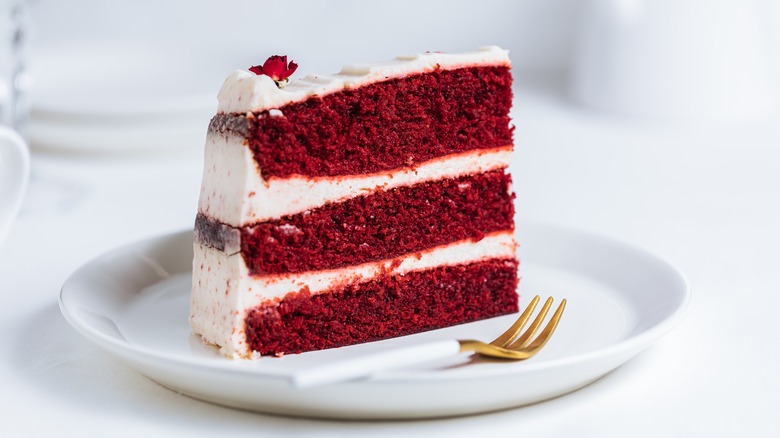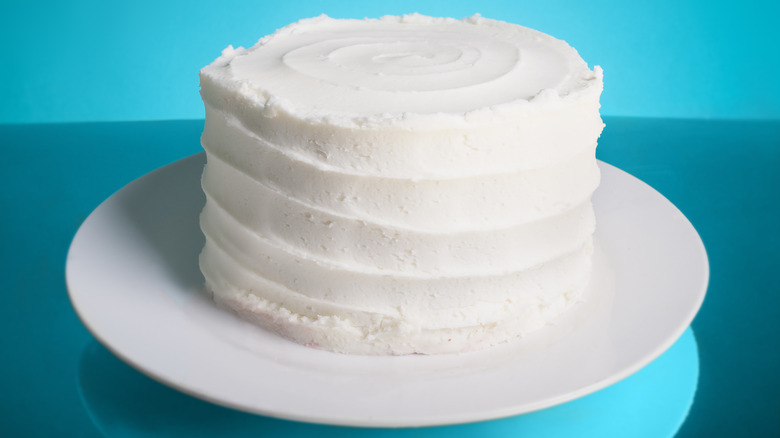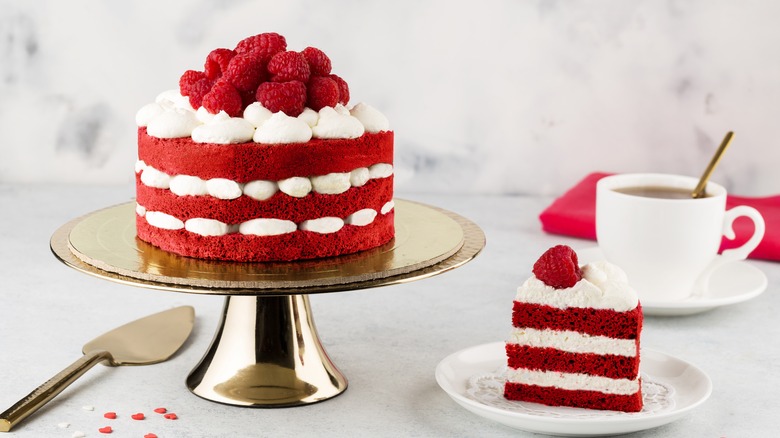White Vs Red Velvet: Which Cake Came First?
In the 21st century, red velvet cake has emerged as the clear winner of the Great Velvet Cake Popularity War. Bet they didn't teach you about that one in school! While pink, black, blue, and rainbow velvet cakes exist, nothing tops the mass appeal of red velvet. Vividly scarlet and topped with white icing, this perennially beloved confection is a favorite for any cake-eating celebration, especially Valentine's Day. The difference between red and, say, blue velvet cakes comes down to the coloring used to dye the sponge. But how about white velvet, which isn't colored at all? Where does it fit into the pantheon of cakes?
When you start thinking about all those colors of velvet cake, perhaps you've wondered which one was the original. Was it red velvet — the undisputed champ — or perhaps a plain white velvet cake, unadorned by any coloring? White velvet cake is lesser known and very different from red velvet in a big way: Red velvet has cocoa in it, and white velvet does not. It is highly probable that the white velvet cake was the original velvet cake that came on the scene several decades before its red counterpart.
White velvet cakes were a Victorian obsession
Queen Victoria was a lady who loved her sweets. Before her eponymous era, cakes were coarser and not as delicate. Under her reign, a finer, more tender cake came along — one with a "velvet" texture, so to speak. These newly christened velvet cakes made their way across the Atlantic Ocean, where American pastry chefs of the 1860s and 1870s popularized the recipes by publishing them in magazines read by home bakers. In contrast, red velvet cakes weren't spied in America until after the turn of the 20th century.
White velvet cake may no longer enjoy rock star status in the culinary world, and you won't find a box mix for one. Boxed cake mixes forever changed home baking with convenience, but they tend to be available only in very basic flavors. Still, home cooks are discovering that white velvet makes the ideal birthday cake: Free of dyes, soft as a cloud, and easy to decorate for any occasion. You, too, can make your own spin on white velvet, which uses only egg whites to ensure a pristine color and buttermilk and cornstarch in the batter for that ultra-fluffy, supple bite.
Red velvet may have been a spinoff of devil's food cake
In the 1910s, a "red devil cake" appeared, a variation on Devil's food cake that turned reddish from the combination of sour milk and baking soda in the ingredients. Devil's food, of course, is a rich chocolate cake. Mignon Francois, an award-winning Nashville baker, told Southern Living, "A long, long time ago, they were notorious for coming up with dramatic names for things ... so Devil's food cake was named because it was sinfully delicious."
The alchemy that snatched Devil's food cake's popularity and lent it to red velvet is murky. New York City's famous Waldorf-Astoria Hotel is usually agreed to be the birthplace of the cake. Still, it really came to prominence in the Midwest and South by way of state fairs and the movie "Steel Magnolias."
Old-fashioned red velvet cake got its hue from a chemical reaction from the natural red anthocyanin in cocoa, which deepens in color when exposed to an acid like vinegar or buttermilk, but today, most recipes rely on artificial coloring. If you are avoiding those additives, there are natural alternatives. Beet juice is the quintessential dye for red velvet, but you can try substituting dry red wine for that signature crimson tint.


